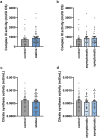Mitochondrial complex III activity: from invasive muscle biopsies to patient-friendly buccal swab analysis
- PMID: 37316639
- PMCID: PMC10267125
- DOI: 10.1038/s41598-023-36741-w
Mitochondrial complex III activity: from invasive muscle biopsies to patient-friendly buccal swab analysis
Abstract
Drug-induced mitochondrial dysfunction is a common adverse effect, particularly in case of statins-the most prescribed drugs worldwide. These drugs have been shown to inhibit complex III (CIII) of the mitochondrial oxidative phosphorylation process, which is related to muscle pain. As muscle pain is the most common complaint of statin users, it is crucial to distinguish it from other causes of myalgia to prevent unnecessary cessation of drug therapy. However, diagnosing CIII inhibition currently requires muscle biopsies, which are invasive and not practical for routine testing. Less invasive alternatives for measurement of mitochondrial complex activities are only available yet for complex I and IV. Here, we describe a non-invasive spectrophotometric method to determine CIII catalytic activities using buccal swabs, which we validated in a cohort of statin and non-statin users. Our data indicate that CIII can be reliably measured in buccal swabs, as evidenced by reproducible results above the detection limit. Further validation on a large-scale clinical setting is recommended.
© 2023. The Author(s).
Conflict of interest statement
The authors declare no competing interests.
Figures





Similar articles
-
Statin-Induced Myopathy Is Associated with Mitochondrial Complex III Inhibition.Cell Metab. 2015 Sep 1;22(3):399-407. doi: 10.1016/j.cmet.2015.08.002. Cell Metab. 2015. PMID: 26331605
-
Statin Treatment Decreases Mitochondrial Respiration But Muscle Coenzyme Q10 Levels Are Unaltered: The LIFESTAT Study.J Clin Endocrinol Metab. 2019 Jul 1;104(7):2501-2508. doi: 10.1210/jc.2018-01185. J Clin Endocrinol Metab. 2019. PMID: 30299473 Clinical Trial.
-
Non-invasive evaluation of buccal respiratory chain enzyme dysfunction in mitochondrial disease: comparison with studies in muscle biopsy.Mol Genet Metab. 2012 Mar;105(3):457-62. doi: 10.1016/j.ymgme.2011.11.193. Epub 2011 Nov 30. Mol Genet Metab. 2012. PMID: 22189081
-
[Statins and mitochondria].Postepy Biochem. 2016;62(2):77-84. Postepy Biochem. 2016. PMID: 28132458 Review. Polish.
-
Exercise-induced myalgia may limit the cardiovascular benefits of statins.Cardiovasc Drugs Ther. 2013 Dec;27(6):569-72. doi: 10.1007/s10557-013-6483-8. Cardiovasc Drugs Ther. 2013. PMID: 23934075 Review.
Cited by
-
Fluvastatin-induced myofibrillar damage is associated with elevated ROS, and impaired fatty acid oxidation, and is preceded by mitochondrial morphological changes.Sci Rep. 2024 Feb 9;14(1):3338. doi: 10.1038/s41598-024-53446-w. Sci Rep. 2024. PMID: 38336990 Free PMC article.
References
-
- Cholesterol Treatment Trialists C, et al. The effects of lowering LDL cholesterol with statin therapy in people at low risk of vascular disease: Meta-analysis of individual data from 27 randomised trials. Lancet (Lond., Engl.) 2012;380:581–590. doi: 10.1016/S0140-6736(12)60367-5. - DOI - PMC - PubMed
MeSH terms
Substances
LinkOut - more resources
Full Text Sources
Medical
Research Materials

